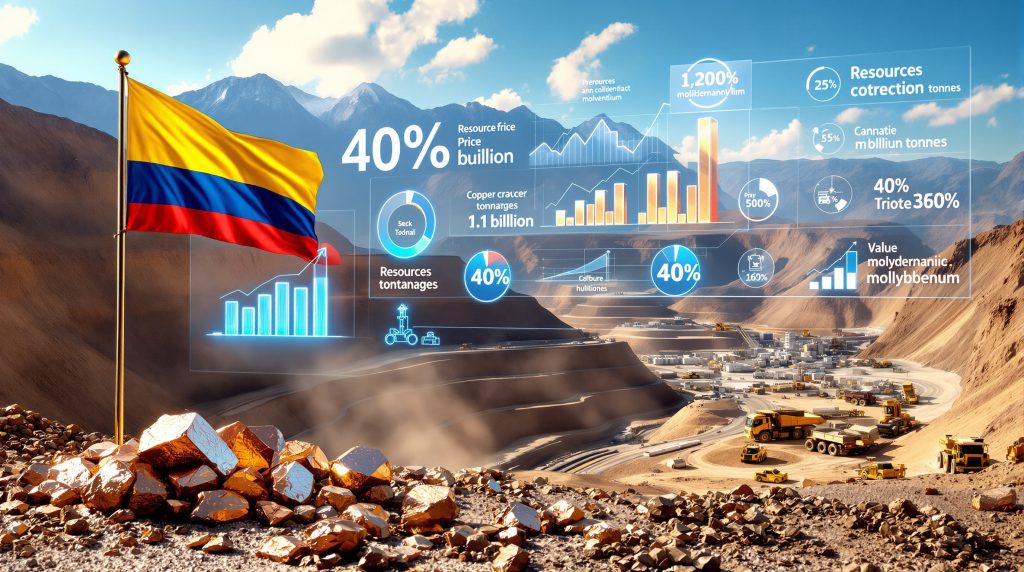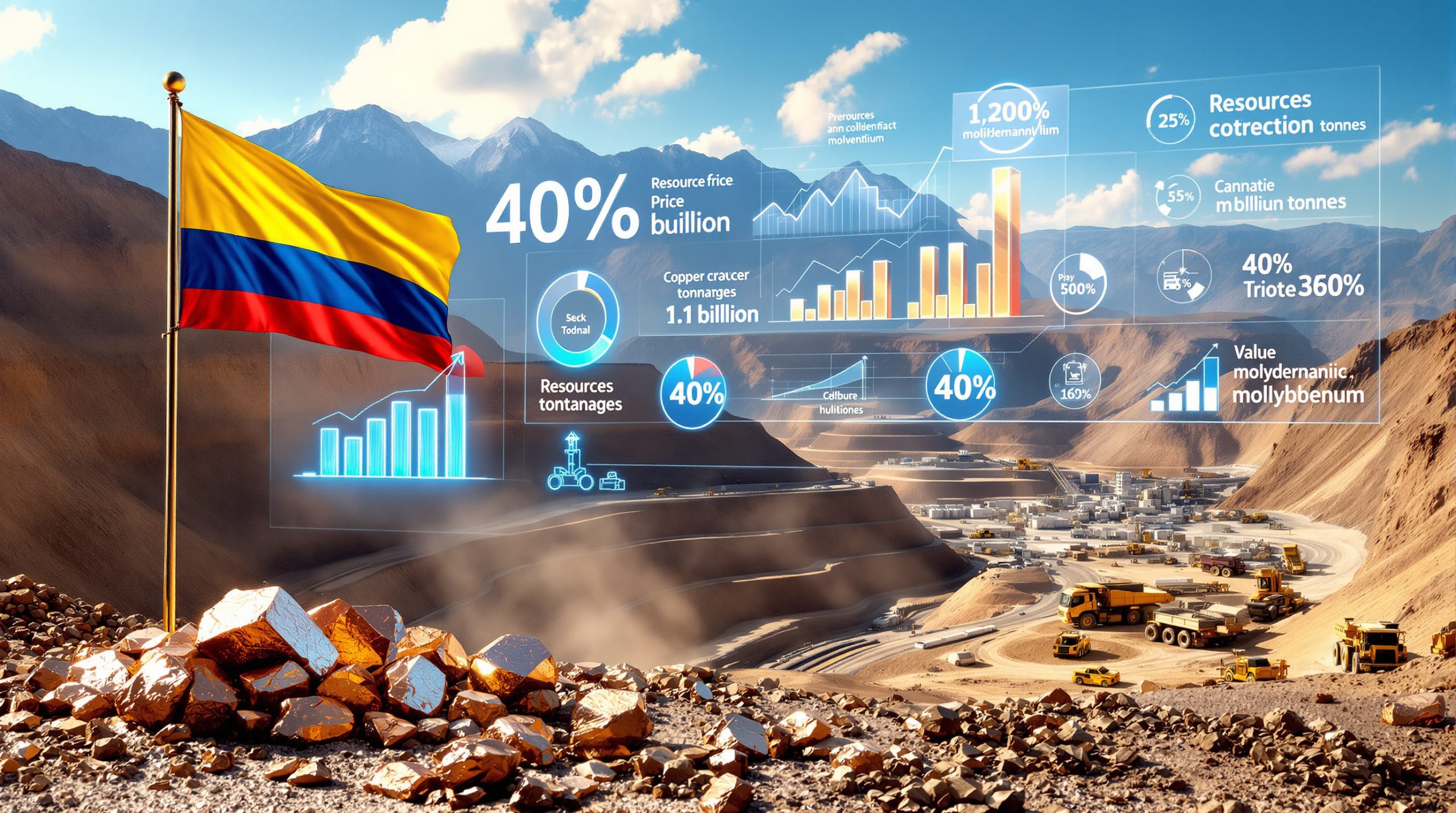Executive Summary – Why Billion-Tonne Copper Assets Command Premium Valuations
The global mining industry operates under fundamental scale economics that create distinct valuation tiers for copper projects. Unlike precious metals exploration, where hundreds of viable gold companies compete for capital, copper consolidation has produced only five to six major producing entities worldwide. This concentration reflects the capital-intensive nature of porphyry copper development and the requirement for multi-decade mine lives to justify investment. Furthermore, the copper giant Mocoa expansion represents a prime example of these tier-one characteristics.
Resource Base Characteristics
- Total Resource: 1.12 billion tonnes at 0.51% copper equivalent
- Starter Pit Zone: 190 million tonnes at 0.94% copper equivalent
- Molybdenum Content: Over 1 billion pounds contained molybdenum
- Molybdenum Recovery: Up to 97% from preliminary metallurgical testing
- Molybdenum Economic Contribution: Approximately 40% of total project value
The rarity of billion-tonne, near-surface copper deposits creates what industry participants describe as a tier-one classification system. Projects achieving this scale threshold enter exclusive consideration by major mining houses, which prefer developing fewer, larger operations rather than managing multiple smaller mines. This preference stems from capital allocation efficiency and the operational complexity of managing geographically dispersed mining operations.
Risk Mitigation Through Phased Development
The 190 million tonne starter zone at 0.94% copper equivalent represents a fundamental risk reduction mechanism. This configuration enables initial production without full project capital expenditure, allowing cash flow from high-grade zones to fund subsequent expansion phases. The phased approach addresses industry concerns following major project cost overruns, including the Pascal Lama development that exceeded $8 billion before termination in 2018.
"The combination of scale and grade creates economic leverage that transforms standard processing infrastructure into significantly higher-value operations through grade multiplier effects."
Market Context – The Structural Copper Deficit Reality
Global Supply-Demand Imbalance Fundamentals
Major investment banks, including Morgan Stanley, project 2026 as potentially the largest copper deficit in two decades. This projection reflects accelerating electrification demand coinciding with declining global copper supply and extended mine development timelines. The structural challenge differs fundamentally from precious metals markets due to copper's immediate industrial consumption patterns.
Industrial Consumption Dynamics
Copper markets lack the above-ground inventory buffers characteristic of gold and silver markets. While precious metals benefit from extensive recycling networks and store-of-value hoarding, copper consumption occurs primarily through permanent infrastructure integration. Consequently, construction, electrical systems, and renewable energy installations embed copper in ways that prevent rapid scrap recovery during supply shortages.
Grade Degradation Timeline
| Metric | Current Industry Average | Copper Giant Mocoa Expansion |
|---|---|---|
| Average Grade | ~0.3% CuEq | 0.51% CuEq |
| Starter Zone Grade | N/A | 0.94% CuEq |
| Resource Scale | Variable | 1.12 billion tonnes |
| Development Status | Various | Near-surface accessible |
Capital Allocation Preferences in Major Mining Houses
Mining companies demonstrate clear preferences for projects meeting specific scale and grade thresholds. The concentration of copper production among fewer entities reflects both capital requirements and operational expertise needed for successful porphyry development. Projects failing to achieve billion-tonne scale typically struggle to attract major company attention, regardless of other favourable characteristics.
Electrification Demand Acceleration
Electric vehicle adoption and renewable energy deployment create copper demand trends that exceed typical mine development timelines. New copper projects require 13-26 years from discovery to commercial production, while electrification technologies deploy on 5-10 year cycles. This temporal mismatch creates structural supply-demand imbalances that traditional inventory mechanisms cannot address.
Technical Asset Analysis – Porphyry System Characteristics
Geological Significance of Multi-Phase Mineralisation
The copper giant Mocoa expansion demonstrates exceptional geological characteristics through its extended mineralisation period. Company exploration work indicates a ten million-year window from first to last porphyry pulse, suggesting system longevity comparable to only two other known projects globally. This extended timeframe creates multiple grade distribution zones that enable selective mining strategies.
Multi-Phase Porphyry Model
Recent drilling programmes identified additional porphyry phases, expanding understanding of the mineralisation system's complexity. Each intrusive phase contributes distinct metallurgical characteristics, with molybdenum concentration patterns indicating deep-seated, high-temperature formation conditions. Furthermore, the alteration footprint analysis reveals expansion potential beyond current resource boundaries.
Metallurgical Recovery Optimisation Potential
Preliminary metallurgical testing indicates 97% molybdenum recovery rates, significantly exceeding typical industry performance of 85-92%. These results, while requiring validation at larger scales, suggest processing advantages that could enhance project economics. Copper-molybdenum separation processes represent well-established technology, reducing metallurgical risk.
Processing Flexibility Advantages
- Initial processing capacity: 30,000 tonnes per day capability
- Expansion pathway: 60,000 → 90,000 → 150,000 tonnes per day potential
- Grade distribution enables selective mining optimisation
- Processing plant design supports phased development strategies
Strategic Development Pathway Analysis
Phased Construction Risk Mitigation Strategy
The 190 million tonne, 0.94% copper equivalent starter zone represents a fundamental departure from traditional large-scale mining development. Rather than requiring full-project capital expenditure before revenue generation, the high-grade zone enables cash flow-positive operations that can fund subsequent expansion phases. This approach addresses industry concerns about capital overruns and extended payback periods.
Capital Efficiency Framework
Grade multiplier effects create significant economic leverage within identical processing infrastructure. A 0.94% ore produces approximately three times the copper per processing unit compared to 0.3% ore, generating dramatically different net present value and internal rate of return profiles from the same capital investment. This mathematical relationship explains why grade receives priority consideration in project evaluation.
Infrastructure Integration Advantages
Existing transportation corridors reduce initial capital requirements while port access enables direct export capability. The regional mining services ecosystem provides operational support infrastructure that reduces development complexity. In addition, these factors contribute to shortened development timelines compared to greenfield locations requiring complete infrastructure development.
Payback Period Optimisation
High-grade zones enable accelerated capital recovery through grade sequencing strategies. Initial mining focuses on the highest-grade materials, maximising early cash flow while establishing operational systems. Lower-grade resources provide long-term production sustainability after initial capital recovery, creating optimal economic profiles for major mining company evaluation.
Geopolitical Risk Assessment – Colombia Investment Climate
Electoral Transition Window Opportunities
Colombia's political landscape presents complex investment considerations. The current administration maintains approximately 25% approval ratings, suggesting potential policy shifts following May 2025 presidential elections. Historical precedent demonstrates successful mining development under diverse political frameworks, including leftist administrations in neighbouring countries.
US Strategic Interest Indicators
Colombia's designation as a Major Non-NATO Ally provides investment protection frameworks that distinguish it from higher-risk jurisdictions. US embassy engagement regarding the copper giant Mocoa expansion indicates recognition of the project's strategic importance for critical minerals supply chain diversification. This diplomatic interest reflects broader Western Hemisphere supply security initiatives.
Bilateral Trade Relationship Dynamics
The breakdown of globalised supply chains creates opportunities for Western Hemisphere mining projects. Unlike previous decades when supply source mattered less, current geopolitical tensions emphasise supply chain security. Critical minerals designation creates US government support mechanisms that favour projects in allied countries.
Window of Opportunity Analysis
Electoral transitions create policy realignment periods that can benefit properly positioned mining projects. New administrations typically require job creation and investment attraction, creating alignment between national development goals and major mining projects. However, the timing of technical milestones with political transitions represents strategic positioning for project advancement.
Critical Metals Co-Product Economics
Molybdenum Market Fundamentals
What makes molybdenum valuable in copper projects? Molybdenum represents 40% of the copper giant Mocoa expansion's economic value due to its critical role in high-temperature steel applications, wind turbine manufacturing, and defence systems. With over one billion pounds of contained molybdenum, the project ranks among the world's largest undeveloped molybdenum resources.
Strategic Supply Concentration Risks
- US Critical Minerals List inclusion since 2022
- High-temperature steel applications in renewable energy infrastructure
- Supply concentration creates price volatility opportunities
- Co-product economics improve overall project margins significantly
Strategic Metals Supply Chain Implications
Molybdenum's unique metallurgical properties make it irreplaceable in specific applications. The highest-quality stainless steels resistant to extreme temperatures require molybdenum additions, particularly in wind turbine and defence applications. This technical requirement creates inelastic demand that supports price premiums during supply constraints.
Recovery Rate Advantages
Molybdenum's physical properties create processing advantages within porphyry systems. Unlike copper, which can remobilise and redistribute during geological processes, molybdenum accumulates without significant migration. Each porphyry pulse increases molybdenum concentration, creating zones of exceptional grade that enhance overall project economics.
Comparative Valuation Framework Analysis
Peer Group Positioning Metrics
Large-Scale Copper Project Valuations
| Project | Resource (Gt) | Grade (% CuEq) | Market Cap | $/lb Cu Resource |
|---|---|---|---|---|
| Pebble (Alaska) | 6.5 | 0.40 | $500M | $0.12 |
| Casino (Yukon) | 1.6 | 0.62 | $180M | $0.15 |
| Copper Giant Mocoa | 1.12 | 0.51 | $40M | $0.04 |
Valuation Discount Analysis
The current enterprise value represents a significant discount to peer group valuations on a per-pound copper resource basis. At $0.04 per pound of copper resource, the copper giant Mocoa expansion trades at substantial discounts to comparable projects. This differential reflects political risk premiums and market recognition gaps rather than fundamental project quality differences.
Resource Expansion Potential
Ongoing exploration programmes continue expanding the resource base through stepout drilling strategies. The absence of identified boundaries in multiple directions suggests additional resource growth potential. Consequently, each successful expansion drill programme provides revaluation catalysts that could narrow valuation gaps with peer projects.
Investment Catalyst Timeline – Upcoming Value Drivers
Near-Term Technical Milestones
2025 Development Timeline
- Ongoing 14,000-meter drilling programme results (Q1-Q2 2025)
- Updated resource estimate incorporating expansion drilling (Q2 2025)
- Preliminary Economic Assessment completion (August 2025)
- Metallurgical optimisation studies advancement (continuous)
Political and Regulatory Catalysts
Colombia's electoral cycle creates policy framework opportunities that could benefit the copper giant Mocoa expansion. New administrations typically require job creation and investment attraction, potentially creating alignment between national development goals and major mining projects.
Catalyst Synchronisation Strategy
- Presidential election outcomes (May 2025)
- New administration mining policy framework (Q3 2025)
- Environmental permitting progress (2025-2026)
- Community agreement implementations (ongoing)
The timing of technical milestone completion with political transitions represents strategic positioning for project advancement. Preliminary Economic Assessment publication following electoral stabilisation could optimise market reception and policy alignment.
Risk Factor Assessment Matrix
Technical Development Risks
Resource expansion drilling may not maintain grade consistency across all target zones. While current results demonstrate continuity, geological systems can exhibit grade variation that affects economic assumptions. Furthermore, metallurgical recovery rates require validation at pilot plant scales before commercial confirmation.
Infrastructure Development Considerations
- Processing plant capital costs may exceed preliminary estimates
- Environmental permitting timeline uncertainties
- Community relations require continuous engagement investment
- Currency fluctuation impacts on capital cost estimates
Political and Regulatory Considerations
Electoral outcomes may impact mining policy frameworks, though historical precedent suggests successful project development under diverse political leadership. Environmental compliance standards continue evolving, requiring adaptive management strategies. However, community engagement represents ongoing operational requirements rather than one-time achievements.
Risk Mitigation Strategies
The phased development approach reduces political risk exposure by enabling project advancement through multiple electoral cycles. High-grade starter zones provide economic resilience during policy transition periods. In addition, community investment and local employment creation build political support across different administrations.
Institutional Investment Implications
Portfolio Positioning Considerations
The copper giant Mocoa expansion provides institutional investors with large-scale copper exposure during a projected structural deficit period. Critical metals diversification through molybdenum co-product creates additional value streams aligned with supply chain security initiatives. The emerging market development opportunity combines with developed-market partnership potential through US strategic interest.
ESG Integration Opportunities
Community engagement programmes demonstrate environmental, social, and governance considerations that institutional investors increasingly prioritise. Local employment creation and infrastructure development contribute to positive social impact metrics. For instance, the project's alignment with renewable energy supply chains supports ESG investment mandates.
Strategic Acquisition Potential
Scale and grade characteristics position the project for major mining company acquisition consideration. US government strategic interest may facilitate acquisition discussions by providing policy support frameworks. Furthermore, the phased development approach reduces acquisition integration risks while infrastructure advantages support accelerated development timelines.
Capital Market Access
Tier-one project characteristics enable access to larger capital pools typically reserved for billion-tonne scale developments. Major mining companies and sovereign wealth funds demonstrate preference for projects meeting scale thresholds that justify management attention and capital allocation.
Strategic Value Proposition Summary
The copper giant Mocoa expansion represents a convergence of technical excellence, strategic timing, and geopolitical opportunity that creates compelling investment characteristics. The combination of billion-tonne scale, high-grade starter zones, and critical metals co-product economics addresses multiple institutional investment criteria simultaneously. This convergence aligns with current copper price insights and copper investment strategies being discussed in the market.
Investment Thesis Convergence
Multiple factors align to create investment opportunity timing that may not persist indefinitely. Political transition windows in Colombia, combined with increasing US strategic interest in Western Hemisphere critical minerals projects, suggests institutional investors have limited time to establish positions before broader market recognition drives valuation normalisation. These trends complement broader mineral exploration insights regarding the industry's development patterns.
The structural copper deficit timeline, projected to intensify through the remainder of this decade, creates favourable market conditions for large-scale, high-grade projects. The copper giant Mocoa expansion's technical characteristics position it advantageously within this supply-demand environment.
Risk-Adjusted Return Profile
The phased development strategy addresses institutional concerns about capital deployment risks while maintaining exposure to full project value creation. Political risk mitigation through community engagement and historical precedent reduces country-specific concerns that have historically created valuation discounts for Latin American mining projects.
Institutional investors seeking exposure to the structural copper deficit, critical minerals supply security, and large-scale mining development may find the current valuation environment provides attractive entry points before broader market recognition of the project's tier-one characteristics.
Ready to Capitalise on the Next Major Copper Discovery?
Discovery Alert instantly alerts investors to significant ASX mineral discoveries using its proprietary Discovery IQ model, turning complex mineral data into actionable insights. Understand why major mineral discoveries can lead to substantial market returns by exploring Discovery Alert's dedicated discoveries page, showcasing historic examples of exceptional outcomes, then begin your 30-day free trial today to position yourself ahead of the market.




